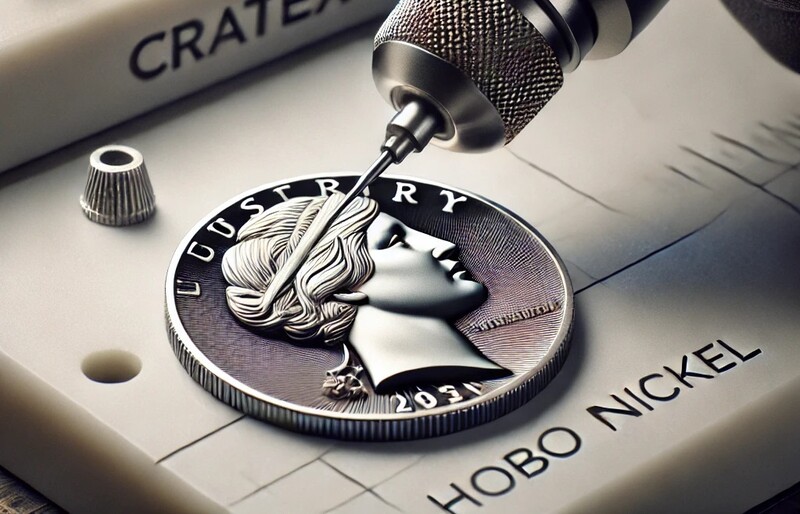A Short History of Coin Carving | CRATEX Abrasives
This article is part of Hobo Nickel – Remarkable Coin Art series.
For full article click here
The hobo-style coin modification of coins dates back to at least 18th century if not sooner. The most common form found during the early 1850s was the “potty coin”, which was a modified silver coin depicting the Goddess of Liberty seating on a potty.
This was also the golden era for love tokens. Those were coins with one or both smooth sides, carved with initials, names, monograms, different scenes, etc. and often included into necklaces or bracelets. The craze for love tokens finally faded out in the beginning of 20th century.
Serious hobo nickel art started in 1913 when the Buffalo nickel entered circulation. Craftsmen began using various homemade tools to re-carve the Indian head. The most frequent theme was the standard design of a man with a derby, but there were also various other themes that appeared both on the front and the back (with back carvings being far rarer than the front ones). Some of the images that appeared on the front of the nickel were of other Indians, solders, women, Rabbis, clowns, and some of the themes that appeared on the back were animals, such as a turtle, a donkey or a buffalo, miniature man and box cars.
The art really took off during the Great Depression. Many were unemployed, so they spend a lot of their free time breathing their own designs into the coins, typically by using primitive tools such as nails, pocket knives, screwdrivers, pieces of metal, etc.
The period between 1940s and 1970s was a period of transition and important changes. Jefferson nickel gradually replaced the Buffalo nickel causing it to disappear almost completely from circulation by the end of 1970s, many new artists appeared, the style and the themes became modern, subjects more diverse, new techniques and tools, such as vibrating tools and power engravers, were introduced, color was added and so on.
Many old-school carvers continued their work on Buffalo nickels well into the 1980s. It was the time of standard hobo nickel design of a man wearing a rounded derby hat, with a beard, ear showing and a collar. More complicated variations included a cigar, cigarette, changed profile or some words added. It was also the time when many modern subjects entered the art, such as images of people of various occupations, famous people, etc. Once again, many new artists started to appear and produce carvings with non-traditional subjects, such as skulls, conquistadors or comic strip character Dick Tracy.
During the 1990s more modern subjects appeared, such as various cartoon characters, withes and animals, and it is also the time when serious hobo coin professionals appeared, producing superior quality carvings. They stirred away from producing a great number of lower-quality carvings per year to producing fewer coins that had higher artistic quality and value.
Nevertheless, the mass production of modern lower-quality carved coins continued well to this day, so $5 coins are expected to surpass the old hobo nickels in number within the next few years.
